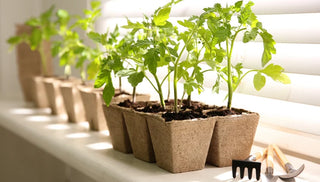As the garden centers (including ours here in Vermont) fill up with 6-packs of irresistible little vegetable and flower seedlings, it’s good to remember what a shock it can be for those plants to go from greenhouse to your garden. Without a little preemptive TLC, “transplant shock” can interrupt their growth and set them back by two or three weeks.
Here are a couple ways to ease the transition:
 When shopping for plants, keep your eyes out for seedlings that are displayed outdoors (rather than inside a greenhouse). Having already been exposed to wind, sun and variations in temperature, they’ll have a running start on the vagaries of life in the garden. If greenhouse plants are the only option, bring them home and keep them outdoors in a sheltered location for four or five days so they can toughen up.
When shopping for plants, keep your eyes out for seedlings that are displayed outdoors (rather than inside a greenhouse). Having already been exposed to wind, sun and variations in temperature, they’ll have a running start on the vagaries of life in the garden. If greenhouse plants are the only option, bring them home and keep them outdoors in a sheltered location for four or five days so they can toughen up.
Seek out plants that are well-matched to the size of the pot they’re growing in. If the plants look too small, they may have been recently transplanted and won’t yet have developed a strong root system. Plants that are big and overgrown will have a tangled root mass that’s too small to support the top growth. If in doubt, gently tap the pot or tray and ease out the root ball to take a look. For most annual flowers and vegetables, healthy roots will be white and fleshy.
 An overcast day with calm wind is ideal for transplanting. If the weather doesn’t cooperate, be prepared to cover the plants immediately with garden fabric to protect them from windburn, sunburn and chilly temperatures. Even an hour or two of wind or hot sun is enough to cause harm. Depending on weather, the crop and the weight of the fabric, seedlings can stay under this protective cover for several weeks.
An overcast day with calm wind is ideal for transplanting. If the weather doesn’t cooperate, be prepared to cover the plants immediately with garden fabric to protect them from windburn, sunburn and chilly temperatures. Even an hour or two of wind or hot sun is enough to cause harm. Depending on weather, the crop and the weight of the fabric, seedlings can stay under this protective cover for several weeks.
Plants should be settled into the garden at the same soil level as they were growing in their pots. Tomatoes are the exception to this rule, because they are able to sprout roots all along their stems. With large tomato seedlings you can carefully remove the bottom leaves and bury the roots and stem so only the top 4-6″ of the plant shows above the soil level.
 Soak all transplants thoroughly before putting them into the garden. Move individual plants from pot to soil quickly so their roots are exposed to the air as briefly as possible. Once planted, immediately soak the entire area to establish good capillary action between the newly-disturbed soil and the surrounding soil. Soaking means watering slowly to moisten the soil to a depth of 3-4″. If possible, give these new plants a strengthening drink of seaweed or seaweed-fish fertilizer. Those vitamins and other nutrients are easy for plants to absorb and will help minimize stress.
Soak all transplants thoroughly before putting them into the garden. Move individual plants from pot to soil quickly so their roots are exposed to the air as briefly as possible. Once planted, immediately soak the entire area to establish good capillary action between the newly-disturbed soil and the surrounding soil. Soaking means watering slowly to moisten the soil to a depth of 3-4″. If possible, give these new plants a strengthening drink of seaweed or seaweed-fish fertilizer. Those vitamins and other nutrients are easy for plants to absorb and will help minimize stress.
It takes several weeks for young transplants to develop new roots and begin drawing moisture and nutrients from the surrounding soil. Until this time, monitor your plants daily to make sure the root zone doesn’t dry out.





